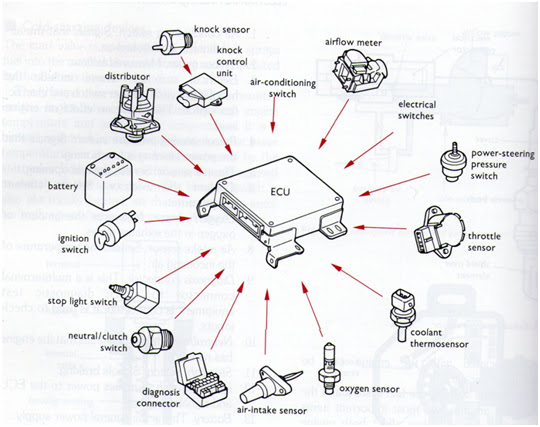Exhaust Gas Analysis
In today’s class we covered exhaust emissions and then in practical used an exhaust analyser to analyse the emissions on our own vehicles. This blog covers the steps we took to carry out testing and our readings, I’ll explain each reading and what the results show.
Firstly we setup the exhaust analyser so that it could calibrate the system, it needs to get a good reading of the oxygen so the analyser probe was not inserted when the machine was calibrating.
*When carrying out tests it is important to do them in an open space to avoid CO poisoning which can be deadly.
The readings we got were:
CO (Carbon Monoxide) = 0.001
Means: Shows almost no amount of CO which is expected because probe has not been inserted in exhaust, the reason I got the above reading is because there were a couple of cars running so there were traces of CO in the air.
HC (Misfire):12
Means: There is no detonation or burnt gas in the air so the reading is 12ppm, this reading will change when the analyser probe is inserted.
CO² (Carbon Dioxide) = 0.00
Means:The reading was 0.00 this is because it was only reading the fresh air so there shouldn’t be any readings unless the car is running in a closed of space for a while.
O2 (oxygen) = 20.90
Means:O2 is high because it is reading the oxygen in the air so it should be high, this will change when test are carried out on the vehicle.
Start the engine idling cold and then insert the analyser probe into the tailpipe of the vehicle and allow it to analyse the emissions.
The readings I got at Cold Idle are:
CO=2.89
Means:The CO is high because the engine is cold so it is running a richer air/fuel mixture.
HC=788ppm
Means:Because the engine is cold there is a richer air/fuel mixture and also there is some misfiring occurring.
CO2=12.6
Means:The CO2 will slowly increase as the engine warms up, this is because the higher the carbon dioxide reading the more efficient the engine is operating.
O2=5.15
Means:Because the car has just been started there is still some O2 in the exhaust system this will decrease as the car warms up.
Next readings are with the engine warmed up.
The readings are:
CO=0.58
Means:The engine is now warm so the air/fuel mixture is not very rich so there is a lower CO output.
HC=235ppm
Means:The mixture is not rich anymore as the engine is using less fuel, therefore the HC has dropped and there is less misfire.
CO2=14.2
Means:With the engine running a operating temperature the CO2 is slightly increased and more ideal, this is because ideal combustion produces large amounts of CO2 and H2O.
O2=1.10
Means:With a warm engine more of the O2 is being burnt so less O2 is exerted from the chamber.
The next reading is with the engine warm and running at 2500RPM.
The readings are:
CO= 2.5
Means: because the engine is running at 2500rpm the air fuel is richer because more fuel is being injected into the mixture.
HC= 434ppm
Means: Air/fuel mixture is very rich because the throttle is open and therefore more fuel is being forced into the chamber.
CO2= 10
Means: because the engine is running rich the CO2 is lower and this shows that the engine is not operating not efficiently.
O2= 1.3
Means: the air/fuel mixture is burning smoothly so O2 remains low; this shows that isn’t much misfiring occurring.
Basically the readings vary on the condition that the engine is under; if the car is cruising then it will run efficiently so CO2 and HC will be low. And when the car is speeding or under load then the air/fuel mixture will be rich, so the CO and HC will be high indicating that the car isn’t running efficiently.







